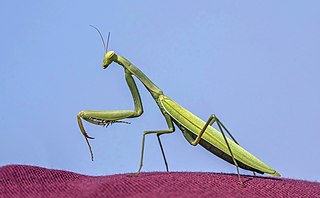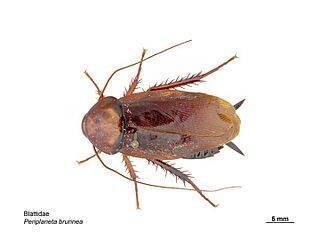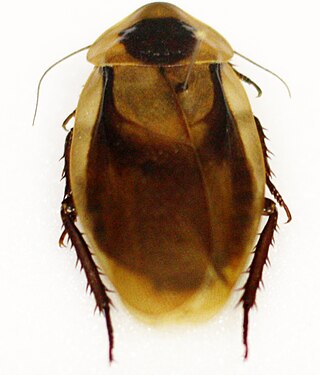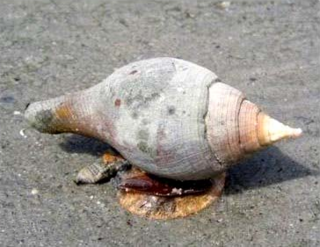
An ootheca /oʊ.əˈθiːkə/ (pl.: oothecae /oʊ.əˈθiːsiː/ ) is a type of egg capsule made by any member of a variety of species including mollusks (such as Turbinella laevigata ), mantises, and cockroaches. [1] [2] [3]

An ootheca /oʊ.əˈθiːkə/ (pl.: oothecae /oʊ.əˈθiːsiː/ ) is a type of egg capsule made by any member of a variety of species including mollusks (such as Turbinella laevigata ), mantises, and cockroaches. [1] [2] [3]
The word is a Latinized combination of oo-, meaning "egg", from the Greek word ōon (cf. Latin ovum ), and theca, meaning a "cover" or "container", from the Greek theke. Ootheke is Greek for ovary.
Oothecae are made up of structural proteins and tanning agents that cause the protein to harden around the eggs, providing protection and stability. [1] The production of ootheca convergently evolved across numerous insect species due to a selection for protection from parasites and other forms of predation, as the complex structure of the shell casing provides an evolutionary reproductive advantage (although the fitness and lifespan also depend on other factors such as the temperature of the incubating ootheca). [4] [5] Oothecae are most notably found in the orders Blattodea (Cockroaches) and Mantodea (Praying mantids), as well as in the subfamilies Cassidinae (Coleoptera) and Korinninae (Phasmatodea). [6]
The ootheca protects the eggs from microorganisms, parasitoids, predators, and weather. Its composition and appearance vary depending on species and environment. [7] [8] [3]

Dictyoptera is an insect superorder that includes two extant orders of polyneopterous insects: the order Blattodea and the order Mantodea (mantises). All modern Dictyoptera have short ovipositors and typically lay oothecae. The oldest fossils of Dictyoptera from the Late Carboniferous, referred to as "roachoids" have long ovipositors and did not lay oothecae. The oldest modern oothecae-laying dictyopterans date to the Late Triassic.

The European mantis is a large hemimetabolic insect in the family of the Mantidae ('mantids'), which is the largest family of the order Mantodea (mantises). Their common name praying mantis is derived from the distinctive posture of the first pair of legs that can be observed in animals in repose. It resembles a praying attitude. Both males and females have elongated bodies with two pairs of wings. The most striking features that all Mantodea share are a very mobile, triangular head with large compound eyes and their first pair of legs, which is highly modified for the efficient capture and restraint of fast-moving or flying prey.

The American cockroach is the largest species of common cockroach, and often considered a pest. In certain regions of the U.S. it is colloquially known as the waterbug, though it is not a true waterbug since it is not aquatic. It is also known as the ship cockroach, kakerlac, and Bombay canary. It is often misidentified as a palmetto bug.

The Florida woods cockroach is a large cockroach species which typically grows to a length of 30–40 mm (1.2–1.6 in). When alarmed, adults can eject an extremely foul-smelling directional spray up to one metre (3.3 ft), which inspired several of its other common names: Florida skunk roach, Florida stinkroach, skunk cockroach, skunk roach, stinking cockroach, and stinkroach. Two other naming variations include Florida cockroach and Florida woods roach.

The smokybrown cockroach is a large species of cockroach, winged, and growing to a length of 32–35 millimetres (1.3–1.4 in).

The brown cockroach is a species of cockroach in the family Blattidae. It is probably originally native to Africa, but today it has a circumtropical distribution, having been widely introduced. In cooler climates it can only survive indoors, and it is considered a household pest.

Blattodea is an order of insects that contains cockroaches and termites. Formerly, termites were considered a separate order, Isoptera, but genetic and molecular evidence suggests they evolved from within the cockroach lineage, cladistically making them cockroaches as well. The Blattodea and the mantis are now all considered part of the superorder Dictyoptera. Blattodea includes approximately 4,400 species of cockroach in almost 500 genera, and about 3,000 species of termite in around 300 genera.

Cockroaches are insects belonging to the order Blattodea (Blattaria). About 30 cockroach species out of 4,600 are associated with human habitats. Some species are well-known pests.

Blaberus discoidalis, commonly known as the discoid cockroach, tropical cockroach, West Indian leaf cockroach, false death's head cockroach, Haitian cockroach, and drummer, is a cockroach native to Central America of the "giant cockroach" family, Blaberidae.

The death's head cockroach is a species of cockroach belonging to the family Blaberidae. It is often confused with the discoid cockroach, Blaberus discoidalis, due to its similar appearance. It is distinguished by jet black cloak-like marking on its wings and a skull-shaped, amber/black marking on its pronotum. The name death's head comes from the markings on the top of the pronotum: "cranii", which is Latin for "of the head", and "fer", meaning "carry" or "carrier". Due to their unique appearance and certain characteristics, they make an easy to care for pet or display insect for entomologists and hobbyists.

Blaberus giganteus, the Central American giant cave cockroach or Brazilian cockroach, is a cockroach belonging to the family Blaberidae. One of the world's largest cockroaches, it is native to the warm parts of the Neotropical realm.

Evaniidae is a family of parasitoid wasps also known as ensign wasps, nightshade wasps, hatchet wasps, or cockroach egg parasitoid wasps. They number around 20 extant genera containing over 400 described species, and are found all over the world except in the polar regions. The larvae of these solitary wasps are parasitoids that feed on cockroaches and develop inside the egg-cases, or oothecae, of their hosts.

"Roachoids", also known as "Roachids", "Blattoids" or Eoblattodea, are members of the stem group of Dictyoptera. They generally resemble cockroaches, but most members, unlike modern dictyopterans, have generally long external ovipositors, and are thought not to have laid ootheca like modern dictyopterans.

Orthodera novaezealandiae, known as the New Zealand mantis or New Zealand praying mantis, is a species of praying mantis which is, as both the scientific name and common names suggest, indigenous and endemic to New Zealand.

Turbinella laevigata, common name the Brazilian chank, is a species of very large sea snail with a gill and an operculum, a marine gastropod mollusk in the subfamily Turbinellinae of the family Turbinellidae.

Mantises are an order (Mantodea) of insects that contains over 2,400 species in about 460 genera in 33 families. The largest family is the Mantidae ("mantids"). Mantises are distributed worldwide in temperate and tropical habitats. They have triangular heads with bulging eyes supported on flexible necks. Their elongated bodies may or may not have wings, but all Mantodea have forelegs that are greatly enlarged and adapted for catching and gripping prey; their upright posture, while remaining stationary with forearms folded, has led to the common name praying mantis.

Evania appendigaster, also known as the blue-eyed ensign wasp, is a species of wasp in the family Evaniidae. Its native range is not known, but it likely originated in Asia. Today it occurs throughout the tropics and subtropics and in many temperate regions. As with the rest of its family, the blue-eyed ensign wasp is a parasitoid known for specializing on cockroach eggs.

Parcoblatta uhleriana, the Uhler's wood cockroach, is a species of Parcoblatta native to the United States and Canada. It is a forest species also found in disturbed and urban environments. The male of the species flies freely, while the female does not fly.
Podagrion mantis was first described in 1886 by W.H. Ashmead and was the first species of its genus to have been described from the United States. All species in the genus are parasitoid wasps known only to parasitize mantids. They have been observed most often utilizing the egg case (ootheca) of Stagmomantis carolina, but have also been reported to choose S.limbata or Tenodera angustipennis as hosts, showing a high degree of specialization.
{{cite book}}: CS1 maint: others (link)